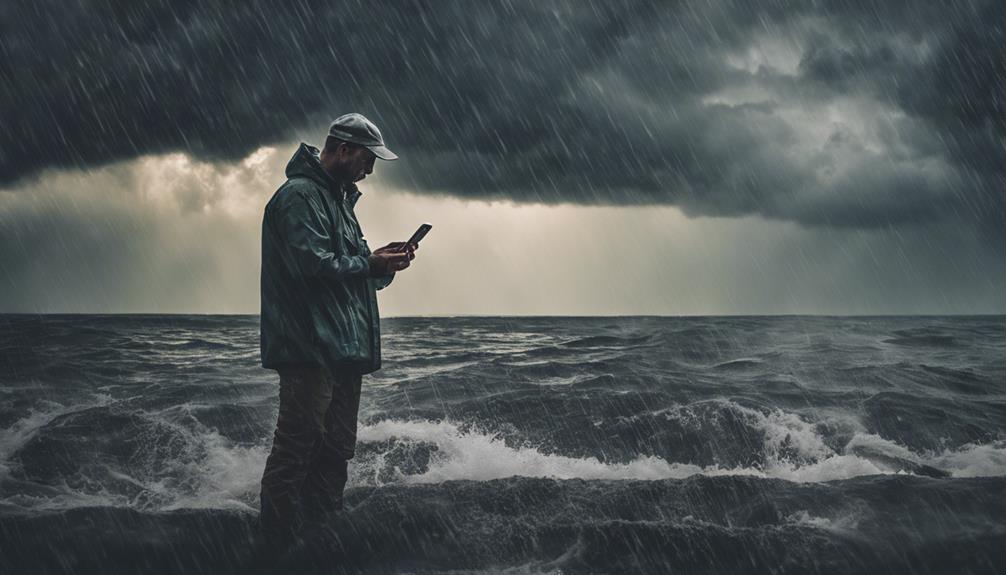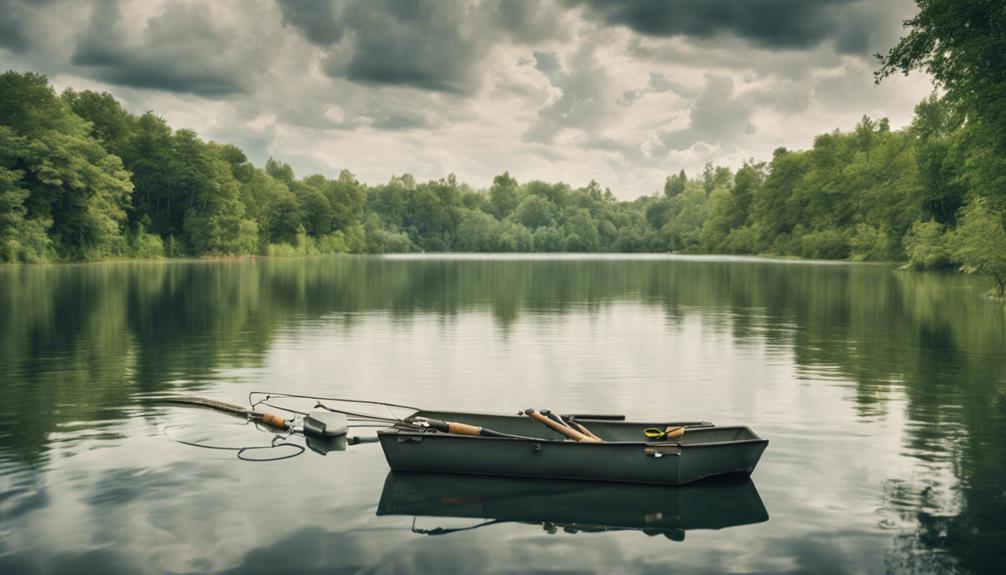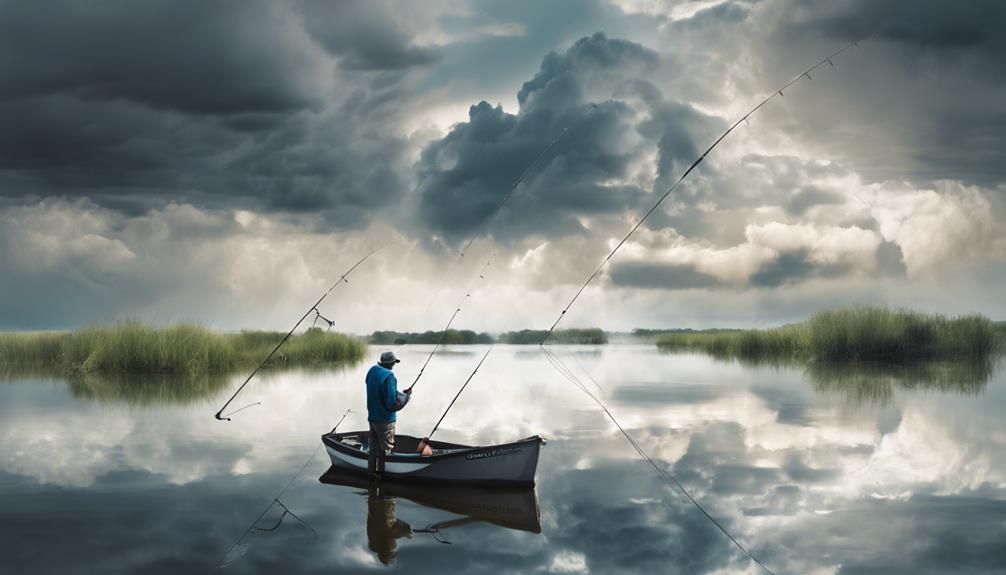Understanding fishing weather forecasts is crucial for optimizing your fishing outcomes. Factors like tides, moon phases, wind patterns, barometric pressure, and temperature directly impact fish behavior. Wind direction can guide you to fish locations, while pressure shifts influence fish activity levels. Water temperature affects fish metabolism, and cloud cover alters feeding patterns. Adjusting your strategies based on weather predictions enhances your chances of a successful fishing trip. By considering these weather elements, you can align your fishing techniques with the conditions to increase your chances of a fruitful day on the water.
Importance of Fishing Weather Forecasts
Understanding Fishing Weather Forecasts plays a crucial role in enhancing angler success rates and ensuring safety on the water. One key aspect of these forecasts is the prediction of tides. Tides have a significant impact on fish behavior and, therefore, directly influence fishing success. By knowing the timing and intensity of tides, anglers can plan their fishing trips more effectively. For example, during high tide, fish tend to move closer to shore, making them easier to catch. On the other hand, during low tide, fish may retreat to deeper waters, requiring different fishing techniques.
Another important factor to consider is the influence of moon phases on fish behavior. Different moon phases can trigger specific feeding patterns in fish. For instance, during a full moon, some fish species are more active at night, while during a new moon, they may feed more actively during the day. Understanding these patterns can help anglers determine the best times to fish and the most suitable bait to use.
Factors Affecting Fishing Weather
Factors influencing fishing weather include atmospheric pressure, wind patterns, and temperature fluctuations, all of which play a critical role in determining fishing conditions. Water currents are a significant factor affecting fishing weather. They can influence the movement of fish and the distribution of prey, impacting where fish are likely to be found. Moon phases also play a role, affecting tides and fish behavior. Understanding how these factors interact can greatly improve your fishing success.
Air pressure is another crucial element to consider. Fish are sensitive to changes in air pressure, and these changes can affect their feeding behavior. Low pressure often leads to increased fish activity, while high pressure may result in decreased activity. Humidity is also important. High humidity levels can make fish more active near the surface, while low humidity may drive them to deeper waters.
Temperature fluctuations can significantly impact fishing weather. Fish are cold-blooded creatures, meaning their activity levels are influenced by water temperature. Warmer water can lead to increased fish activity, while colder water may slow down their metabolism. By monitoring these temperature changes, you can adjust your fishing techniques accordingly to increase your chances of a successful catch. Understanding these factors and how they interplay is essential for any angler looking to make the most out of their fishing trips.
Reading Wind Patterns for Fishing
When observing wind patterns for fishing, analyze the direction and speed to determine their impact on fish behavior and your fishing strategy. Wind direction plays a crucial role in where fish might be located in the water. For example, if the wind is blowing towards a certain shore, fish tend to follow the current and gather in that area to feed. Understanding wind patterns can help you position your boat or choose the right spot on the shore to increase your chances of a successful catch.
Additionally, wind speed can affect the behavior of fish. Strong winds might cause fish to seek shelter in calmer waters, while moderate winds could create ripples on the surface that make it harder for fish to spot your bait. Adjusting your fishing technique based on the wind speed can lead to better results. For instance, using heavier lures or sinkers in windy conditions can help your bait reach the desired depth without being blown off course.
In terms of fishing strategies, anglers should consider the wind direction when casting their lines. Casting against the wind can be challenging and affect the distance and accuracy of your cast. It's advisable to position yourself in a way that allows you to cast with the wind for better control and efficiency. By paying attention to wind patterns and adapting your approach accordingly, you can optimize your fishing experience and increase your chances of a successful outing.
Understanding Barometric Pressure
Analyzing the impact of barometric pressure on fish behavior and fishing strategies involves monitoring changes in atmospheric pressure. Barometric pressure fluctuations play a significant role in determining fishing success. Fish are sensitive to these pressure changes, which can affect their feeding habits and movement patterns.
When the barometric pressure is high and rising, fish tend to move towards deeper waters, making them more challenging to catch. Conversely, when the pressure is low or falling, fish are typically more active near the surface or in shallower areas, presenting better opportunities for anglers.
Understanding how barometric pressure correlates with weather patterns is crucial for adjusting fishing techniques. For instance, as a low-pressure system approaches, bringing with it overcast skies and potentially stormy conditions, fish may become more active and easier to catch. During these times, using topwater lures or live bait can be particularly effective.
In contrast, high-pressure systems with clear skies often result in fish being less active, requiring anglers to use different strategies such as fishing deeper or using slower presentation methods.
Impact of Temperature on Fishing
Exploring the effect of temperature on fishing success involves closely monitoring water temperatures and their influence on fish behavior and feeding patterns. Temperature fluctuations play a significant role in determining fish activity levels and their movement patterns. Fish are ectothermic, meaning their body temperature is regulated by the external environment, making them highly sensitive to water temperature variations. Understanding how weather patterns influence water temperature is crucial for developing effective fishing strategies.
Fish behavior is intricately linked to temperature changes. In general, warmer water temperatures increase fish metabolism, leading to heightened activity levels and a greater willingness to feed. Conversely, colder water temperatures can slow down fish metabolism, causing them to be less active and feed less frequently. This knowledge can help anglers decide on the best times to fish based on the prevailing temperatures.
Weather patterns such as cold fronts or heatwaves can cause rapid fluctuations in water temperature, directly impacting fish behavior. During cold fronts, fish may become lethargic and move to deeper, warmer waters, making them harder to catch. On the other hand, heatwaves can increase fish activity near the surface as they seek cooler areas. Adapting fishing strategies to these temperature variations is essential for maximizing your chances of a successful catch.
Cloud Cover and Fishing Success
Cloud cover plays a crucial role in determining fishing success by influencing fish behavior and feeding patterns. The amount of cloud cover directly affects sunlight intensity, which in turn impacts the behavior of fish. On bright, sunny days with minimal cloud cover, the sunlight penetrates the water, increasing visibility. This can make fish more cautious and less likely to venture into shallower areas, affecting your choice of fishing spots.
Conversely, when the sky is overcast, the reduced sunlight intensity can make fish more active and willing to feed in shallower waters. In such conditions, fishing techniques that involve lures or baits that mimic wounded prey can be particularly effective. Additionally, fish may be more inclined to gather in schools near the surface under cloudy skies, presenting an opportunity for successful surface fishing.
Cloud cover also plays a role in water visibility. In clear water bodies, bright sunlight can make fish more wary and harder to catch. However, when the sky is cloudy, reduced visibility can work to your advantage by providing cover for stealthier approaches to your fishing spots.
Understanding how cloud cover influences fish behavior and the conditions it creates in the water is essential for adapting your fishing strategy to maximize success on any given day.
Significance of Precipitation in Fishing

When precipitation occurs, it significantly influences fish behavior and feeding patterns, impacting your fishing strategy and success. Rainfall impacts fishing success by altering various factors in the aquatic environment. Weather patterns play a crucial role in determining the type and intensity of precipitation, which in turn affects fish activity.
Rainfall can lead to increased water flow in rivers and streams, washing terrestrial insects and other food sources into the water. This abundance of food can trigger feeding frenzies among fish, making them more active and likely to bite. Conversely, heavy rain can also muddy the water, reducing visibility and making it harder for fish to locate prey, causing them to be less active.
Moreover, changes in barometric pressure associated with precipitation events can influence fish behavior. Many species of fish are sensitive to these pressure changes and may feed more aggressively before a storm but become lethargic during and after rainfall.
Understanding how different weather conditions, including precipitation, impact fish behavior is essential for adjusting your fishing techniques accordingly. By paying attention to weather forecasts and recognizing the effects of rainfall on fish activity, you can adapt your strategies to maximize your chances of a successful fishing trip.
Utilizing Weather Apps for Fishing
Have you considered how weather apps can enhance your fishing experience by providing real-time meteorological data tailored to your location and fishing preferences?
Weather apps designed for fishing enthusiasts offer a range of functionalities to improve your user experience on the water. These apps provide up-to-date information on crucial weather parameters such as wind speed, direction, temperature, barometric pressure, and precipitation forecasts, all of which play a significant role in determining the success of your fishing trip.
One of the key advantages of using weather apps for fishing is the accuracy and reliability of the weather data they provide. By leveraging advanced meteorological algorithms and data from reliable sources, these apps can offer forecasts specific to your exact fishing location. This precision allows you to make informed decisions about when and where to fish, increasing your chances of a successful outing.
Moreover, weather apps often come with additional features such as sunrise and sunset times, tide information, and moon phases, which can further optimize your fishing strategy. By understanding how these factors influence fish behavior, you can plan your trips more effectively and maximize your catch.
Frequently Asked Questions
Can Fishing Weather Forecasts Predict Specific Fish Behavior?
Fishing weather forecasts can provide valuable insights into fish movement and behavior. By analyzing weather patterns, you can anticipate how different conditions may affect fish activity.
While forecasts can't predict specific fish behavior with absolute certainty, they can offer general trends that experienced anglers use to make informed decisions.
Understanding these forecasts can help you adapt your fishing strategies accordingly to increase your chances of a successful catch.
How Do Lunar Phases Affect Fishing Success?
During different lunar phases, tidal movements play a crucial role in fish activity. Understanding moon phases helps you plan your angler strategy more effectively.
For example, during full and new moons, tidal movements are stronger, leading to increased fish activity. Anglers can use this knowledge to target specific areas where fish are more likely to be active, enhancing their chances of a successful fishing trip.
Is There a Difference in Fishing Success Between Freshwater and Saltwater Based on Weather?
When comparing freshwater and saltwater fishing based on weather, you'll find differences in success rates. Tidal patterns influence catch rates in saltwater, with certain species more active during specific tides.
Wind direction plays a significant role in both environments, affecting fish behavior and feeding habits. Understanding these factors can help you choose the right conditions for a successful fishing trip, whether in freshwater or saltwater locations.
Are There Specific Weather Conditions That Attract Certain Fish Species?
During different seasons, specific weather conditions influence fish activity and migration patterns. Temperature variations play a crucial role in attracting certain fish species to different areas.
For example, warmer waters might lure tropical fish species, while colder temperatures could prompt the movement of cold-water fish. Understanding these seasonal patterns and how they relate to fish behavior can significantly impact your fishing success.
How Accurate Are Long-Term Weather Forecasts for Fishing Trips?
Long-term weather forecasts for fishing trips can be moderately accurate in predicting general weather patterns. While they provide a good overview, specific details like wind speed or precipitation can vary.
Understanding these forecasts can enhance your fishing success by helping you plan accordingly. However, always be prepared for unexpected changes in weather conditions while on your fishing trips.
Stay informed, stay safe, and enjoy your time on the water!
Conclusion
In conclusion, understanding fishing weather forecasts is crucial for successful fishing trips. By considering factors such as wind patterns, barometric pressure, temperature, cloud cover, and precipitation, anglers can increase their chances of a productive day on the water.
Utilizing weather apps can provide real-time updates and help fishermen make informed decisions. By staying informed and adapting to changing weather conditions, anglers can optimize their fishing strategies and increase their chances of a successful catch.



